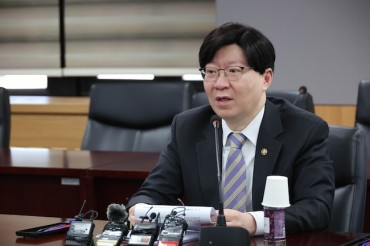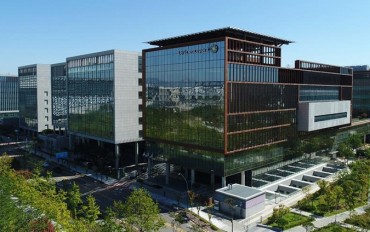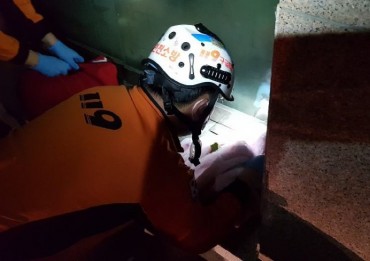
Modern clothing shopping malls in Dongdaemun market, South Korea’s sleepless fashion mecca. (Image : Yonhap)
SEOUL, Dec. 11 (Korea Bizwire) – While in college in the early 2000s, Lee Eun-sun used to go to the Dongdaemun market to buy casual clothes, hopping from one shopping complex to another.
Walking through the narrow aisles lined up with cramped stores without partitions, she learned how to bargain with shop owners over prices, often paying in cash for extra discounts.
Now, Dongdaemun clothing shops are not her first choice for affordable, trendy clothes anymore.
The 34-year-old office worker in Seoul searches online malls for pencil skirts and fashionable blouses. When Japanese fashion retailer Uniqlo holds discount events, she buys heat retaining underwear and winter sweaters in bulk.
“Back then, going to Dongdaemun meant that I’m going to shop for cheap trendy clothes. I often bumped into people because small stores inside the shopping malls were always crowded,” Lee said.
“During my recent visit there, I spotted many Chinese tourists in some of the big shopping malls in Dongdaemun and other smaller ones were far quieter than they used to be. The atmosphere was quite different from foreign brand shops such as Zara and H&M, which are crowded with younger shoppers.”
The Dongdaemun market in central Seoul is the second-most visited tourist attraction in South Korea following Myeongdong, housing manufacturers, wholesalers and retailers in a mixture of modern and traditional setting.
Started as a traditional market a century ago, the market underwent a major facelift in the 1970s to become the center of the textile industry. The area was reborn as the most famous fashion street after several modern shopping complexes, including Doosan Tower and Migliore, flocked there in the late 1990s and the early 2000s.’
While wholesalers and traditional markets open through the night until 4 a.m. are busy with retailers and tourists, the retail business hasn’t been so good over the past years amid growing popularity of specialty brands and online shopping malls.
Except leading retail stores such as Doosan Tower and Lotte Fitin, both operated by conglomerates, more than half of the upper floor at smaller shopping complexes remain empty despite discounts on rental fees, according to the shoppers’ association.
“Buildings built by real estate developers more than a decade ago have cramped shopping spaces and lack of toilets,” one male clothing shop owner at Hello apM said, asking for anonymity. “Business is not as good as it used to be. That’s why you see empty spaces here.”
Industry experts say Dongdaemun retailers have lost their competitive edge to global fast fashion brands in terms of price and quality,
Specialty retailers of private label apparel (SPA) brands such as Zara of Spain, H&M of Sweden, often called as fast fashion brands, have made an aggressive foray into South Korea over the past years, expanding their shops on mega shopping malls and major retail strips.
“Dongdaemun fashion brands have mostly targeted younger customers who more appreciated a new look that can be worn for the moment at affordable prices,” Ku Ja-myung, the manager at Dongdaemun Fashion BIZ Center said.
“Global fast fashion brands have stolen their target customers by introducing the latest fashion trends at affordable prices, changing the fashion code among youngsters.”
The SPA market rapidly expanded from 500 billion won (US$423.2 million) in 2008 to 3.14 trillion won last year, and is on track to faster growth in the coming years, according to Samsung’s fashion research institute, Samsung Design.
For those who look for a wide range of clothing options and a convenient shopping environment, cramped shopping space in Dongdaemun stores and lack of amenities may be less appealing.
Despite calls to modernize the buildings, shopping malls divided by lots and sold to individual investors by real estate developers find it hard to renovate the facility due to complex ownership and legal procedures, according to Chi Dae-shik, an official at Dongdaemun fashion shopping district association.
“Shopping malls with individually owned stalls lack amenities and do not offer standardized customer service. As a result, people are flocking to modernized SPA brand shops,” Chi said.
The growing popularity of online shopping malls has also put low-tier retailers in an unfavorable position.
“Online shopping malls have been successful in luring fashion-savvy customers by suggesting the hottest fashion styles through look book-like digital storefront and social networking sites,” Ku said. “Plus, you don’t have to care about shop assistants and bargaining prices.”
Rather than trying to catch up with global brands, industry professionals say Dongdaemun should target the niche market by building its own life style brand and using the place to present a distinctive characteristic.
The sprawling fashion market is located near Heunginjimun, National Treasure of Korea No. 1, more commonly known as Dongdaemun (Great East Gate), and Dongdaemun Design Plaza (DDP), the newest landmark designed by world-renowned architect Zaha Hadid.
“The independent businesses cannot catch up with global SPA brands with unrivaled economies of scale. It should not be their goal,” said Cha Hee-cheol, the smart clothing technology service center director at Korea Institute of Industrial Technology.
“Although the area has pools of human and other resources available to foster this area into a global fashion mecca with stories of the past and the present, Dongdaemun hasn’t really succeeded in taking it to the next level. A centralized investment and planning is needed to revitalize this area.”
Industry leaders say the Korean fashion industry should benchmark the success story of Korean cosmetic companies that created strong demand for innovative “K-beauty products,” riding the popularity of Korean pop culture.
Jung Wook-jun, a Korean designer who leads Juun.J, the globally recognized menswear brand, stressed a brand image based on culture and the designer’s identity to develop the local fashion industry, which is more focused on following the next new thing.
“Fashion is usually introduced after culture makes inroads (overseas),” Jung said in press briefing on Nov. 30. “Designer’s consistent identity is the most important.”
For that goal, Cha called for better marketing for tourist attractions and a wide range of clothing selections that also include select shops and high-end brands to bring in more business people and tourists.
“The government, designers and shop owners should step up collaboration to present more authentic styles here, not just following the latest fad and trying to cut the price,” he said. “Dongdaemun is the face of Korea’s fashion industry, and that’s why we have take the time and effort to create a brand image.”
(Yonhap)






